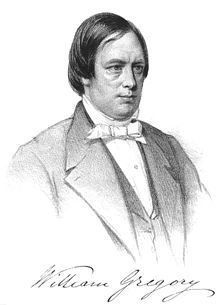Professor William Gregory
| William Gregory (chemist) | |
|---|---|
 |
|
| Born | 25 December 1803 |
| Died |
24 April 1858 (aged 54) Edinburgh |
| Nationality | Scottish |
| Known for |
mesmerism phrenology |
| Scientific career | |
| Fields | chemistry |
Prof William Gregory FRCPE FRSE FCS (25 December 1803 – 24 April 1858) was a Scottish physician and chemist. He studied under and translated some of the works of Liebig, the German chemist. Gregory also had interests in mesmerism and phrenology.
He was the fourth son of James Gregory and Isabella MacLeod, and was born at 2 St Andrews Square in Edinburgh (demolished).
After a medical education he graduated at Edinburgh in 1828, and moved into chemistry, studying at Geissen University. In 1831 he introduced a process for making the "muriate of morphia", which came into general use. "Gregory's salt" in terms of modern chemistry was a mixture of morphine hydrochloride and codeine hydrochloride, obtained from opium by use of calcium chloride.
In the 1830s he is recorded as living in his father's large townhouse with his brothers at 10 Ainslie Place on the Moray Estate in the western New Town of Edinburgh.
In 1832 he was elected a Fellow of the Royal Society of Edinburgh, his proposer being Robert Christison, and served as the Society's Secretary from 1844 to 1858.
After studying for some time on the continent he established himself as an extra-academical lecturer on chemistry at Edinburgh. He was appointed Professor of Chemistry at the Andersonian University, Glasgow, and then at the Dublin Medical School, and in 1839 was appointed professor of medicine and chemistry in King's College, Aberdeen. In 1844 he was elected to the chair of chemistry at Edinburgh in succession to his old teacher Thomas Charles Hope. Andrew Fyfe filled his post in Aberdeen having unsuccessfully also contested the Edinburgh chair. He was a successful expository lecturer, but in his later years suffered much from a disabling disease.
...
Wikipedia
